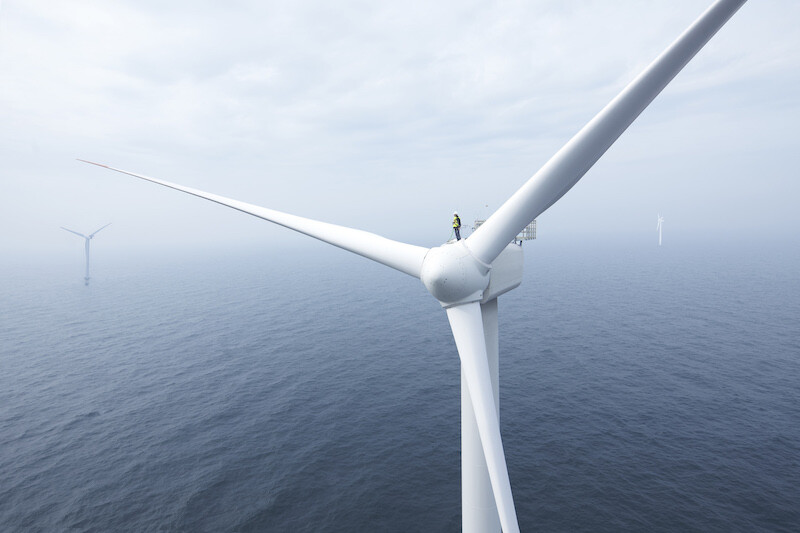President Biden has promised millions in federal government funding for offshore wind development, to be provided through the hotly contested infrastructure bill. But passage of the bill by Congress is far from certain, and a huge federal government offshore wind stimulus package, of any form, is not a given.
Still, as Congress dickers over the details of the bill, local governments are bullish on this new developing sector. From New England to North Carolina to the West Coast and elsewhere in the U.S., states are finding ways to fund development of offshore wind. These efforts, while helpful in building up the sector, collectively fall far short of Biden’s goal of 30 gigawatts of offshore wind energy generation by 2030.
With much disagreement between Republicans and Democrats over the need for and economics of thwarting climate change, bipartisan cooperation will be crucial if the U.S. hopes to come anywhere close to the president’s goal for offshore wind development. One area both sides might find a lot to agree on is the issue of job creation. Americans need well-paying jobs, pretty much everyone agrees.
But to get a better sense of how to move forward while achieving a consensus for offshore wind growth, federal government leaders might be wise to pay more attention to what individual states are doing in this sector. They’re already succeeding.
“State government has really been the reason so much has been invested. The opportunity to earn a competitive return on a stable generation asset” is enticing state governments, said Jason Folsom, principal of Power and Money, an offshore wind consultancy based in Boston. “And offshore wind is now so cheap, governments are thinking about how they can draw the industry to their state.”
Of course, upgrades in technology will be needed for this new sector. It’s currently happening, with the development of new purpose-built vessels and retrofitted vessels for offshore wind projects; but that’s just part of the array of new technologies being developed for offshore projects. More must be done, industry experts say.
“There’s no question that the onshore and offshore transmission system must expand and update its technology to handle 30 GW by 2030. We also will need port improvements and buildouts to handle the massive demand, as well as customized vessels to transport and install these turbines offshore,” said Kyle Kingman, president of Offshore Power LLC.
However, it’s not yet clear whether this fast-growing sector will need long-term, continuous help from government. Growth is fast and interest in the technology is great. For now, whether infrastructure monies come or not, offshore wind in the U.S. has a lot of momentum that should carry it forward for many years. Some states are more proactive than others in this realm.
“Here at home, I have to recognize our leading states, especially New York, New Jersey, and Massachusetts, for their leadership in moving ahead with offshore wind programs,” Kingman said. “These states will reap the rewards for their far-sighted investments.”
Europe, and European companies, have a head start in offshore wind and are helping to develop the nascent U.S. offshore wind sector. Their coveted position of top dog of the global offshore wind sector is not unassailable. Given the bar set by Biden, if the U.S. offshore wind industry can get even near his lofty goal for offshore wind, it may well usurp Europe’s place at the top of the industry.
So what’s needed to build upon existing U.S. growth, to make it the center of innovation, development, and investment in this industry? Cooperation, on a wide-ranging scale. It will take more than the current group of lone states and partnerships of states working toward the goal. And it will take more than the current local governments, investors, and developers working in offshore wind, although these efforts are foundational to much greater success on the horizon.
This gargantuan effort to build a huge industry practically from scratch will, to begin with at least, call for lots of goal-setting. Biden’s goal is a very large one, but in a way it parrots efforts of other leaders of various states.
North Carolina Gov. Roy Cooper’s executive order setting offshore wind development goals of 2.8 GW by 2030 dovetails nicely into the presidential goal. The 813-MW Empire Wind Project, which is New York’s first large offshore wind project, may over time provide new best practices for industry leaders.
All told, states have goals amounting to 29,000 megawatts of offshore wind. Through 13 offshore wind projects, they plan to ultimately deliver 9,100 MW of offshore wind power in the next five years. These and many other projects will help educate U.S. offshore wind developers, equipping them to run an increasingly complex sector.
“There is 13% learning curve with every doubling of installed offshore wind. Today, we have 42 MW installed in the country. I fully expect value from lessons learned,” Folsom said.
Right now, with the various initiatives at the state and local levels to bring offshore wind development up to full steam, combined the with many years of experience (albeit with a limited number of projects) of U.S. maritime pros working in this sector, the groundwork has been laid for a future boom.
“I am very optimistic about the offshore marketplace because of the state and federal programs and commitments I'm seeing to offshore wind. The approval of Vineyard Wind 1 in Massachusetts and the progress of a dozen committed wind farms right behind it means that we are building a once in a generation industry here in the U.S.,” Kingman said. “This will involve the creation of tens of thousands of U.S. jobs, billions in revenue and help the environment. If that doesn't excite you, I don't know what will.”
Some of that growth in the industry will be due to an even newer eco-friendly energy source — green hydrogen.
“Green hydrogen will play a major role here on the East Coast in the not too distant future. We have expansive natural gas infrastructure that we can rapidly up-convert to green H2, which will be needed for firming capacity to support renewable growth from wind and solar,” Folsom said. “Any excess power in the grid can be utilized to generate H2, regardless of source, but hydrogen will be a natural solution to energy ‘storage.’”
One part that’s absent from the long-term plans for U.S. offshore wind is a comprehensive national strategy for it, many experts say. Creating such a plan will greatly help the overall effort. But it’s no substitue for direct action.
“To unlock the full opportunity in offshore wind, all we have to do is build more offshore wind. The more we build the more we create synergy. And the more people who understand this industry and step up and invest, the more likely it is the U.S. can lead. It would be a shame if we do not match goals and do our part to contribute,” Folsom said.




